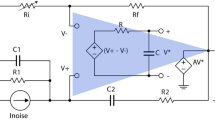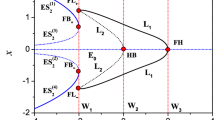Abstract
We investigate analytically and numerically the dynamics of an injection locked in-plane uniform spin torque oscillator for several forcing configurations at large driving amplitudes. For the analysis, the spin wave amplitude equation is used to reduce the dynamics to a general auto oscillator equation in which the forcing is a complex valued function \(\mathcal {F}(p,\psi ) \propto \epsilon _1(p)cos(\psi )+i \epsilon _2(p)sin(\psi )\). Assuming that the oscillator is strongly non-isochronous and/or forced by a power forcing ( \(|\nu \epsilon _1 / \epsilon _2|\gg 1\)), we show that the parameters \(\epsilon _{1,2}(p)\) govern the main bifurcation features of the Arnold tongue diagram: (i) the locking range asymmetry is mainly controlled by the derivative \(d\epsilon _1/dp\), (ii) the loss of stability when the frequency mismatch between the generator and the oscillator increases occurs for a power threshold depending on \(\epsilon _{1,2}(p)\) and (iii) the frequency hysteretic range is related to the transient regime at zero mismatch frequency. Then, the model is compared with the macrospin simulation for driving amplitudes as large as \(10^0-10^3 A/m\) for the magnetic field and \(10^{10}-10^{12} A/m^2\) for the current density. As predicted by the model, the forcing configuration (nature of the driving signal, applied stimuli direction, harmonic orders) affects substantially the oscillator dynamic. However, some discrepancies are observed. In particular, the prediction of the frequency and power locking range boundaries may be misestimated if the hysteretic boundaries are of same magnitude order. Moreover, the misestimation can be of two different types according to the bifurcation type. These effects are a further manifestation of the complexity of the dynamics in non-isochronous auto-oscillators.
Graphical Abstract












Similar content being viewed by others

Data Availability Statement
This manuscript has no associated data or the data will not be deposited. [Authors’ comment: The data are available upon reasonable request.]
References
J.-V. Kim, Spin-Torque Oscillators; Elsevier Inc., Chapter 6, pp 217–294
W.H. Rippard, M.R. Pufall, S. Kaka, T.J. Silva, S.E. Russek, J.A. Katine, Phys. Rev. Lett. 95, 067203 (2005)
R. Lehndorff, D.E. Bürgler, C.M. Schneider, Z. Celinski, Appl. Phys. Lett. 97, 142503 (2010)
A. Hamadeh, G. de Loubens, V.V. Naletov, J. Grollier, C. Ulysse, V. Cros, O. Klein, Phys. Rev. B 85, 140408 (2012)
T. Hache, T. Weinhold, K. Schultheiss, J. Stigloher, F. Vilsmeier, C. Back, S.S.P.K. Arekapudi, O. Hellwig, J. Fassbender, H. Schultheiss, Appl. Phys. Lett. 114, 102403 (2019)
S. Urazhdin, P. Tabor, V. Tiberkevich, A. Slavin, Phys. Rev. Lett. 105, 104101 (2010)
M. Quinsat, J.F. Sierra, I. Firastrau, V. Tiberkevich, A. Slavin, D. Gusakova, L.D. Buda-Prejbeanu, M. Zarudniev, J.-P. Michel, U. Ebels, B. Dieny, M.-C. Cyrille, J.A. Katine, D. Mauri, A. Zeltser, Appl. Phys. Lett. 98, 182503 (2011)
V.E. Demidov, H. Ulrichs, S.V. Gurevich, S.O. Demokritov, V.S. Tiberkevich, A.N. Slavin, A. Zholud, S. Urazhdin, Nat. Commun. 5, 3179 (2014)
P.S. Keatley, S.R. Sani, G. Hrkac, S.M. Mohseni, P. Dürrenfeld, J. Åkerman, R.J. Hicken, Phys. Rev. B 94, 094404 (2016)
E. Jué, M.R. Pufall, W.H. Rippard, Appl. Phys. Lett. 112, 102403 (2018)
M. Rajabali, R. Ovcharov, R. Khymyn, H. Fulara, A. Kumar, A. Litvinenko, M. Zahedinejad, A. Houshang, A.A. Awad, J. Åkerman, Phys. Rev. Appl. 19, 034070 (2023)
B. Fang, M. Carpentieri, X. Hao, H. Jiang, J. A. Katine, I. N. Krivorotov, B. Ocker, J. Langer, K. L. Wang, B. Zhang, B. Azzerboni, P. K. Amiri, G. F. Z. Z. Nature Communications, 7, 11259 (2016)
J. Cai, L. Zhang, B. Fang, W. Lv, B. Zhang, G. Finocchio, R. Xiong, S. Liang, Z. Zeng, Appl. Phys. Lett. 114, 192402 (2019)
G. Finocchio, R. Tomasello, B. Fang, A. Giordano, V. Puliafito, M. Carpentieri, Z. Zeng, Appl. Phys. Lett. 118, 160502 (2021)
J. Grollier, D. Querlioz, M.D. Stiles, Proc. IEEE 104, 2024–2039 (2016)
D. Markovic, N. Leroux, M. Riou, F. Abreu Araujo, J. Torrejon, D. Querlioz, A. Fukushima, S. Yuasa, J. Trastoy, P. Bortolotti, J. Grollier, Appl. Phys. Lett. 114, 012409 (2019)
M. Romera et al., Nature 563, 230 (2018)
D.I. Albertsson, M. Zahedinejad, A. Houshang, R. Khymyn, J. Åkerman, A. Rusu, Appl. Phys. Lett. 118, 112404 (2021)
A. Houshang, M. Zahedinejad, S. Muralidhar, J. Checiński, R. Khymyn, M. Rajabali, H. Fulara, A.A. Awad, M. Dvornik, J. Åkerman, Phys. Rev. Appl. 17, 014003 (2022)
A.A. Awad, P. Dürrenfeld, A. Houshang, M. Dvornik, E. Iacocca, D. R. K., J. Åkerman Nature Physics, 13, 292-299 (2017)
J. Turtle, P.-L. Buono, A. Palacios, C. Dabrowski, V. In, P. Longhini, Phys. Rev. B 95, 144412 (2017)
M.A. Zaks, A. Pikovsky, Euro. Phys. J. B 92, 160 (2019)
P. Tabor, V. Tiberkevich, A. Slavin, S. Urazhdin, Phys. Rev. B 82, 020407 (2010)
R. Bonin, G. Bertotti, C. Serpico, I. D. M., M. d’Aquino, The European Physical Journal B , 68, 221–231 (2009)
C. Serpico, R. Bonin, G. Bertotti, M. d’Aquino, I.D. Mayergoyz, IEEE Trans. Mag. 45, 3441–3444 (2009)
M. d’Aquino, C. Serpico, R. Bonin, G. Bertotti, I.D. Mayergoyz, Phys. Rev. B 82, 064415 (2010)
S. Perna, L. Lopez-Diaz, M. d’Aquino, S. C., Scientific Reports, 6, 31630 (2016)
T. Yamaguchi, N. Akashi, K. Nakajima, S. Tsunegi, H. Kubota, T. Taniguchi, Phys. Rev. B 100, 224422 (2019)
R. Adler, Proc. IEEE 61, 1380–1385 (1973)
A. Slavin, V. Tiberkevich, IEEE Trans. Mag. 45, 1875–1918 (2009)
M. d’Aquino, S. Perna, A. Quercia, V. Scalera, C. Serpico, IEEE Trans. Mag. 53, 1–5 (2017)
A. Quercia, M. d’Aquino, V. Scalera, S. Perna, C. Serpico, Physica B: Condensed Matter 2018, 549, 87–90, 11th International Symposium on Hysteresis Modeling and Micromagnetics (HMM 2017)
V. Puliafito, Y. Pogoryelov, B. Azzerboni, J. Åkerman, G. Finocchio, IEEE Trans. Nanotechnol. 13, 532–536 (2014)
S.M. Rezende, F.M. de Aguiar, A. Azevedo, Phys. Rev. B 73, 094402 (2006)
A. Slavin, P. Kabos, IEEE Trans. Mag. 41, 1264–1273 (2005)
J. Hem, L.D. Buda-Prejbeanu, U. Ebels, Phys. Rev. B 100, 054414 (2019)
A. Pikovsky, M. Rosenblum, J. Kurths, Synchronization: A Universal Concept in Nonlinear Sciences (Cambridge University Press, Cambridge Nonlinear Science Series, 2001)
J. Xiao, A. Zangwill, M.D. Stiles, Phys. Rev. B 72, 014446 (2005)
J. Hem, Mécanismes de Synchronisation Dans Les Oscillateurs à Transfert de Spin. Ph.D. thesis, Grenoble Alpes University, (2018)
M. Tortarolo, B. Lacoste, J. Hem, C. Dieudonné, M.-C. Cyrille, J. A. Katine, D. Mauri, A. Zeltser, L. D. B.-P., U. E., Scientific Reports, 8, 1728 (2018)
Y. Zhou, V. Tiberkevich, G. Consolo, E. Iacocca, B. Azzerboni, A. Slavin, J. Åkerman, Phys. Rev. B 82, 012408 (2010)
G. Finocchio, M. Carpentieri, A. Giordano, B. Azzerboni, Phys. Rev. B 86, 014438 (2012)
Acknowledgements
J. H. acknowledges financial support from DGA. J. H. would like to thank Julie Chapelain for her support during the preparation of the manuscript.
Author information
Authors and Affiliations
Contributions
All the authors contributed equally to the paper.
Corresponding author
Appendices
Conversion to \(m_x\), \(m_y\), \(m_z\) Coordinates
The Hamiltonian spin wave formalism consists in transforming the dynamic of the oscillator from the real space variable \(\textbf{m}(t) =(m_x,m_y,m_z)\) to complex valued variables a(t), b(t) and \(c(t)=\sqrt{p}e^{i\phi (t)}\) with the oscillation power p and the free running phase \(\phi (t)\). The relation between c(t) and the complex variable d(t) used in this report is given by: \(d(t)=c(t)exp(-(i \omega _gt)/n)\).
The trajectory orbit \(p=cst\) in c variable can be expressed in the real space by:
With the function \(\mathcal {G}(x)=\sqrt{1-x^2}\), the ellipticity parameter \(-1 \le \mathcal {B}/\mathcal {A}\le 1\) and \(0 \le \phi < 2\pi \). Some orbits are illustrated in Fig. A1.
Theoretical orbits represented in the real space oriented along the \(\textbf{u}_x\) axis for different ellipticities \(\mathcal {B}/\mathcal {A}\) and oscillation power p. a \(\mathcal {B}/\mathcal {A}=0\), b \(\mathcal {B}/\mathcal {A}=-2/3\) and c \(\mathcal {B}/\mathcal {A}\approx -0.91\) (studied IP-STNO). The power \(p_{opp} = 1/(1+|\mathcal {B}/\mathcal {A}|)\) delimits the in-plane precession mode from the out of plane precession mode
Stability Analysis and Hopf Bifurcation
The dynamical system Eq. 3 is resumed:
To simplify the calculations, we have set \(\theta =0\) and define \(Z(p)=p\Gamma (p)\).
On the first hand, the stationary states of Eq. B.2 must verify the equilibrium conditions \(\dot{p}=0\) and \(\dot{\psi }=0\), which rewrite:
On the other hand, the Jacobian matrix J of Eq. B.2 evaluated at the stationary point \((p,\psi )\) is:
Now, we focus on the quantity \(Tr(J(p,\psi ))\):
Removing \(\psi \) with Eq. B.3a leads to:
Note the useful relation:
with \(\Delta p=p-p_0\) and \(p_0\) the free running power.
Inserted Eq. B.7 in Eq. B.6 gives:
The threshold power \(p_{h}\) is defined by \(Tr(J(p_{h}))=0\) so that we obtain Eq. 9:
Transient regime
The Jacobian matrix \(J(p,\psi )\) Eq. 8 or Eq. B.4 with \(\epsilon _2= 0\) is evaluated at zero detuning (\(\delta =0\), \(p=p_0\), \(\psi =\pi /2\)):
The eigenvalues of the matrix are given by:
The transient regime becomes oscillatory for the condition \(\Delta \Omega _S>\Gamma _p/2\) with the complex eigenvalues:
We denote \(|\lambda |=|\lambda _{\pm }|\) the frequency of the transient oscillation in absence of damping:
If the transient regime is oscillatory, one can define the frequency of the pseudo-oscillation in presence of damping [41, 42]:
There is also the resonant frequency of the system \(\omega _{roll-off}\), which can be measured from the phase noise diagram of the oscillator [40]. Resuming the expression of the phase noise Eq.5 in Ref. [40], \(\omega _{roll-off}\) is obtained by maximizing the denominator:
In our case, the oscillator is strongly non isochronous and the damping \(\Gamma _p\) is weak compared to \(\Delta \Omega _S\), so that the three frequencies become equivalent:
Rights and permissions
Springer Nature or its licensor (e.g. a society or other partner) holds exclusive rights to this article under a publishing agreement with the author(s) or other rightsholder(s); author self-archiving of the accepted manuscript version of this article is solely governed by the terms of such publishing agreement and applicable law.
About this article
Cite this article
Hem, J., Buda-Prejbeanu, L.D. & Ebels, U. Bifurcation analysis of strongly nonlinear injection locked spin torque oscillators. Eur. Phys. J. B 97, 41 (2024). https://doi.org/10.1140/epjb/s10051-024-00677-5
Received:
Accepted:
Published:
DOI: https://doi.org/10.1140/epjb/s10051-024-00677-5




